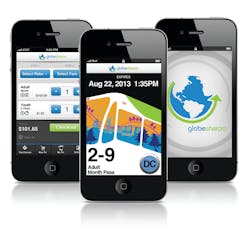For Nat Parker, CEO of GlobeSherpa, the concept of mobile ticketing makes a lot of sense in today’s electronic environment.
Mobile phones — especially smartphones — are now common devices possessed by the vast majority of the populous of North America. Everywhere you look, someone is using one of these phones for various tasks ranging from banking to menial updates to their social media accounts.
One thing Parker noticed is a lot of people use their smartphones while on a bus or a train, but not to access transit.
“We’re transit riders,” Parker said. “You know, it’s funny, it blows me away how many developers when we go to APTA or the Smart Card Alliance is a lot of them don’t ride the bus and they don’t really ride transit. For us, we believe in staying in touch with the experience of the user on an ongoing basis so we can ask ourselves how we can make this easier.”
Rise of the mobile phone
Fare collection companies and transit agencies are pushing mobile ticketing because of opportunities it presents to lower fare collection costs while offering appealing ways for riders to pay. Kim Green, president of SPX Genfare, said unlike traditional fare media, riders purchase the majority of the equipment as opposed to the transit agency and with a Pew Research Center showing 91 percent of adults have cell phones, it shows a deep market penetration.
“In transit it’s still kind of new, but there have been a number of pilot programs using mobile ticketing with some very impressive results,” Green said. “We expect to see this widely adopted in the next several years.”
According to a mobile ticketing report by Juniper Research, one in eight mobile subscribers will use their device for airline, bus, rail festival, cinema and sporting events by 2015. About 500 million people are projected to use a mobile device for transit by 2015.
On Sept. 16, Dallas Area Rapid Transit launched GoPass, its new mobile ticketing option for customers. When launched leaders planned to have 50,000 people download the app and use it, but just six weeks into the program, officials said 25,000 people had already jumped on board.
“At this point we’ve had to revise our overall year end to 60,000,” said David Leininger, executive vice president and chief financial officer for DART. “But when we launched it, we thought at the time that 50,000 was a little aggressive.”
About 1,000 people per day are downloading GoPass, Leininger said, and it was launched to coincide with the Texas State Fair, which draws more than 3.5 million people. With all the downloads, he said they’re also happy with the feedback DART is getting about the mobile ticketing option.
“It has been a very, very good introduction and the customers really, really like it,” Leininger said. “Customers have been giving a lot of positive feedback and we’ve gotten a lot of positive press.”
TriMet and the Portland Streetcar also launched its new ticketing app in September, which was developed by GlobeSherpa to work on both systems. In its first six weeks, Parker said there were 16,000 regular users, 18,000 total users, 158,000 tickets sold and more than $700,000 in sales.
“We didn’t know what to expect, but TriMet had some numbers that were much lower,” Parker said. “We were very bullish on mobile payments.”
Integrating transit with smartphones
Amol Deshmukh, vice president of mobile financial services solutions at Gemalto, said mobile payments are attractive because of the advent of near field communication (NFC) in cell phones, which changes the ticketing infrastructure for transit agencies, who don’t have to use their own equipment as fare media.
It also transforms how passes are used because riders can then use the same app to purchase goods at a nearby store or for other events, which allows agencies to have their app become a common tool for riders to use in everyday life.
“We’re seeing a lot of interest from different players in different industries,” he said. “We have the phone ready to use, so why not have them use it then when they go to Hertz to access a car, or when they check into a hotel. Why does the user have to stop at a front desk when they can start getting their room key on their phone that’s enabled for the hours they’re supposed to be there, so they can then walk directly to their room.”
GoPass is a little more intricate than just acting as a ticket for getting onto DART buses and trains. The app can also be used to board nearby Denton County Transit Authority (DCTA) and Fort Worth Transit Authority (The T), which see a lot of crossover into DART due to the three system’s proximities in the Dallas/Fort Worth area.
The app also has offers and specials for events in the region, next bus information and an integrated trip planner allows users to find their transit route on any system utilizing Google trip planning.
“We really wanted more than a payment product, Leininger said. “We wanted this to be a robust transit product riders will get to use a lot.”
Security in technology
Security is a concern for DART, Leininger said, so when setting up the app planners took the extraordinary measures to make sure the agency or Unwire doesn’t have access to the customer’s credit card information.
“That was very important because the whole issue of who has access to the credit cards, the names, the passcodes is something we don’t have to worry about,” Leininger said.
Leininger said there’s a lot of interest with large venues in the area to allow the GoPass to be a single transaction unit for access to conventions and they’re also developing a push notification system, which with permission by the user, could allow GoPass to send information about events and specials.
Green said a lot of longtime transit riders like the security of having a traditional fare card as opposed to mobile tickets, but questions about the new technology can be overcame with proper planning of new fare collection equipment.
“We believe that agencies need to have a whole myriad of options for customers,” he said. “Some appeal more than others to everyday riders.”
Unlike changes from cash and paper media to fare cards or smart cards, mobile ticketing can be implemented for less cost given mobile devices are purchased by the users, not the agency. Parker said the agency can either implement NFC devices on fare machines or scanners or mobile ticketing can also be used in a flash pass fashion with proper training to operators.
“You can do a tap where the color changes or there’s an animation, so riders can’t just take a screenshot and give it to a friend,” Parker said. “Like on the TriMet ticket it looks like a TriMet bus and you see a city scape, but when you tap on it, it turns on the lights and that’s the Easter egg type of features that riders just absolutely love.”
Deshmukh said there’s also added safety built into the fact that people are more protective of their smartphones than other items, so they take extra care to keep them secure.
“For one, it can start saving money now in costs for cards lost and stole,” Deshmukh said. “The mobile phone is owned by the user and even when it comes to a credit card, if I leave it at a restaurant, I don’t go back in to get it, I cancel it. Maybe that makes me lazy, but it’s easier to go home and call and cancel it.
“But if it’s my phone I leave, I go back and get it. I never leave the parking lot not knowing if I have my phone.”
Growth will remain robust
Mobile ticketing can also be put in place quickly. Leininger said DART signed its contract with Unwire in October 2012, so it only took 11 months to bring it online. The biggest issue with setting up mobile ticketing was training more than 1,000 operators and customer service agents, then developing customer awareness about the new product.
“The technology and this kind of medium is what I’d say is nothing new, Leininger said. “We’re not breaking atoms or anything like that.”
Gemalto is setting up an open loop payment program for the Rio de Janeiro transit system to work with the RioCard. A similar program is being set up to work with the Octopus Card in the Hong Kong transit system.
Parker said mobile ticketing is the future for transit because of the amount of mobile devices being used by the general population and the ease of use it offers to current and potential riders.
“It’s all about the ease of use,” Parker said. “There’s no hassle, no more needing exact change, no more dealing with a clunky machine.”
The addition of mobile ticketing also keeps more money in the system than paying to process payments. Parker said a TriMet audit on the cost of collection show 28 percent of the cost of every ticket went to processing cash payments, 12 percent for paper media to down to 5 percent for mobile ticketing.
“It costs money in terms of the software, the paper media to be loaded in, to refill the ink printers, the armored trucks and the union contracts,” he said. “If you look at cash, it’s really a pain point for these agencies because it’s very different and very expensive to work with cash. We provide a seamless change using what’s already in people’s pockets.”
Although there’s plenty of upside to mobile ticketing, Parker said changes could be made to speed up the process to implementing the new technology.
“I think the bigger challenge overall is the procurement environment and the political atmosphere of trying to get technology to move forward on a relatively fast basis,” he said. “Agencies and their RFP’s, a lot of what goes into them is they’re complied like going out to bid for heavy rail equipment or big, heavy infrastructure where you need to have bonding mechanisms or some kind of securitization of multimillions for covering the liabilities of big heavy infrastructure. Mobile ticketing by its nature is extremely low risk to implement, so much less in the way of physical procurement, so the way to go about this could be significantly reduced as compared to how transit procurement is done today.”
Parker said agencies tend to be risk adverse to brand new technology because leaders are concerned about being penalized for screwing something up, so companies like GlobeSherpa are working to change their mindsets and show them this is something they really need to be paying attention to because of the benefits it can provide.
“This isn’t a panacea. Not every ticket machine or fare box is going to go away,” he said. “But in the longer term it may reduce the cost of ongoing challenges with that equipment, like ticket machines won’t break down as much and won’t need to be replaced as often.”

Joe Petrie | Associate Editor
I came to Mass Transit in 2013 after spending seven years on the daily newsbeat in southeastern Wisconsin.
Based in Milwaukee, I worked as a daily newspaper reporter with the Waukesha Freeman from 2006-2011, where I covered education, county and state government. I went on to cover courts for Patch.com, where I was the main courts reporter in the Metro Milwaukee cluster of websites.
I’ve won multiple awards during the course of my career and have covered some of the biggest political events in the past decade and have appeared on national programs.
Having covered local government and social issues, I discovered the importance of transit and the impact it can have on communities when implemented, supported and funded.





